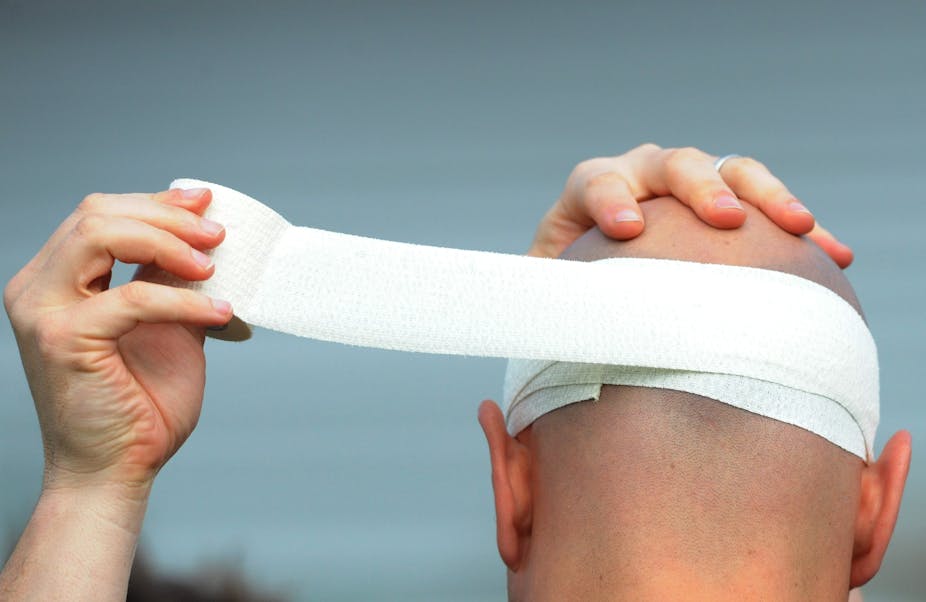Every year we are bombarded by messages about the importance of road safety as holidays approach and regaled every night with state-specific road toll statistics. But we know roads are not the only places where injuries occur and we should know that, for the most part, injuries can be prevented.
To claim society’s effort to prevent injury is an unjustified interference by a “nanny state” in individual freedom is as sensible as to claim society’s efforts to prevent food poisoning are unjustifiable encroachments on the rights of diners.
The truth is that the burden of injury-related death and disability in our community is unacceptably high.
Injuries are not just one of those things over which we have no control. Nor are the causes of injuries entirely within the scope of individual responsibilities.
Injury prevention is not just a matter of common sense.
The burden of injury
Just like any other health condition, injuries are outcomes of sets of circumstances and events that can be addressed using a range of evidence-based interventions.
The burden of injury in Australia could be dramatically reduced if there was better community understanding of the scientific basis of injury control.
Injury is the leading cause of death in Australia for individuals aged between one and 44 years. It accounts for about 10,000 deaths and about 400,000 hospitalisations every year.
The rate of injury requiring hospitalisation and injury mortality in rural and regional areas is one and a half times higher than in urban populations.
The tragedy is that it is all preventable.
Technically, an injury results when the amount of energy delivered to tissue of the body is beyond the limits it can withstand.
Infectious diseases are caused by sets of circumstances that transmit infectious agents, such as bacteria, to an infected person. Similarly, injuries are caused by the set of circumstances that transfer excess energy to an injured one.
When an older person makes a stumbled turn, trips on an uneven surface and falls to the ground, the potential energy she has because of her erect posture is converted to kinetic energy during the falling process.
This kinetic energy is then transmitted through the bones at the point of impact.
If the energy is greater than can be absorbed by the structures and tissues it passes through, a fracture results.
In this example the component causes of the fracture are the uneven surface, the stumbled turn, the person’s strength, balance and bone density, and the nutritional and behavioural history that contributed to the person’s frailty.
The basic principles of injury causation are exactly the same regardless of whether we are talking about injuries from falls, or from earthquakes, workplace incidents, or skateboard and car crashes.
The science of injury prevention
Injury prevention is the process of managing systems to reduce the risk of energy transfer and decrease the probability of an injury outcome.
The prevention of injury across the full range of events uses the same basic approach. The effectiveness of this scientific approach can be clearly demonstrated by the following two success stories.
Throughout the 1980s, the Australian road toll averaged around 3,000 deaths every year. The annual average is now around 1,500 deaths.
This huge reduction was achieved despite the increase in car ownership and distances driven. It was done by coordinated investment and focused application of scientific knowledge.
Effective solutions have addressed three specific areas - better roads, such as those with hard shoulders and divided highways; better vehicles, now with airbags and electronic stability control; and better road user behaviour, with enforced speed and alcohol limits.
New efforts are now being focused on improving the integration of safety initiatives between these three areas.
Road design and advanced road and vehicle technologies are supporting improved road user behaviour, such as through the use of self-explaining roads, and autonomous speed control.
New vehicle technology aimed at improving road user behaviour is defining requirements for road design, such as clear line markings for vehicle lane departure warnings.
In the early 1980s, the rate of drowning deaths of children aged between zero and four was as high as 50 in 100 000 population in some parts of Australia.
A national approach to prevent children drowning was implemented following a concerted effort on the part of researchers, policy makers and practitioners.
Research conducted in the 1980s found private swimming pools accounted for about half the drowning fatalities in this age group.
These studies demonstrated that a four-sided barrier around a pool reduced the risk of drowning by nearly four times compared to direct access to a pool from the house.
On the strength of this evidence, regulatory requirements regarding safety barriers have been introduced in all Australian States and Territories since the early 1990s.
The result is a plummeting toddler drowning rate with the average now at less than 3 for every 100,000.
Scope for benefit
The number of injuries and injury-related deaths, together with the disabling outcomes and the social and economic consequences of these injuries makes injury a leading public health problem.
Solutions to this problem would provide substantial community benefit.
Fortunately, steps for obtaining this benefit are simpler than for almost any other health condition because the solution is readily available.
There needs to be a better coordinated state and national commitment to address injury in the community. We also need a genuine community acknowledgement of the implications of a scientific approach to addressing this major public health issue.
Australia needs to apply the scientific approaches pioneered in the area of road safety and childhood injury to the full spectrum of injury settings.
If the shared responsibility by governments, industry and the community for addressing the issue of infectious diseases were mirrored by society’s efforts to prevent injury, then the latter would not remain the problem it continues to be today.

